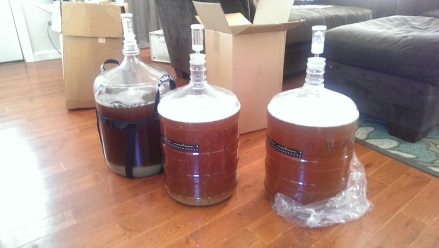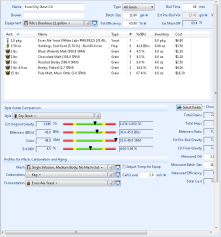
I’ve pushed off updating this post for too long (11 days). Don’t get me wrong, the brew day was amazing. There were about 40 of us with a dozen different beers going at once. We drank good home brew, we shared great stories, we bs’d…it was fun. I even received amazing feedback from some brewers who are opening their own brewery (such as “what is stopping you from going pro?” – best compliment by far). What put a damper on things was not giving myself enough time. All the effort I put into the process may be wasted when I rushed the final product due to a family dinner.
Note: Unfortunately, as I have a new phone, all of my notes are lost. I am trying to recreate the numbers from memory, they are close, but are not precise.
To start, I was impressed that I was able to fit 12+ gallons of water and 38lbs of grain in my 70qt mashtun with a little room to spare. I probably could have fit 3 more pounds in there. The mash went well, my adjustments were a little off (pH around 5.3), but I was not too concerned. First runnings poured off into the kettle and the boil started. I had my pre-boil gravity numbers, but they are now lost in the clouds (or THE “cloud” [or “butt” if you use the “cloud to butt” extension in chrome], but I digress). As this was boiling, I batch sparged and collected my second and third runnings. This I started in my second kettle and got to boiling as well. It was here that I noticed I was running out of time. Due to this, I opted for a 60 minute boil instead of the 90 that I typically do with pilsner malt. I recently heard that the 90 minute is overkill these days with DMS, so I figure I’d chance it. Everything was chilled down to 80F, final gravity readings were taken, and the wort racked into three carboys. I was blown away that the 5 gallons of saison, instead of ringing in at 1.092 as expected, was around 1.104. Very nice extraction on the first runnings. Because of this though, my 11G came in around 1.035 (please note these are estimated from my memory. I remember being blown away breaking 1.1).
Due to having to run out to dinner, the three carboys sat in the cab of my truck at 80F overnight (it was a good dinner). I brought them in the house the next day (it was 3am when we got in, I was beat) and set them by my A/C register. Unfortunately one of the aurlocks popped off and I noticed some krausen looking buildup on top of the wort, almost as if they spontaneously started wild fermenting. I lowered them to the 60s and pitched, allowing them to free-rise back up to 72F. All three one day later showed signs of fermenting and activity.
Fast forward to a week later. I took a sample from the belgian table beers and I taste what may be a slight acetobactor infection, but I can’t tell. It may be off flavors from mid-fermentation. I’m going to let them ride another week or two and re-sample. My goal is to let the saison go for 6 months to a year in my basement untouched.
Recipe
- 34.5lbs Pilsner
- 3.75lbs Munich
- Saaz at 60m
- Saaz at 10m
- Yeasts: Sour Yeast Blend from an old cake mixed with 3711 (5G), WLP 055 Belgian Ale, WY3787 Belgian Trappist

